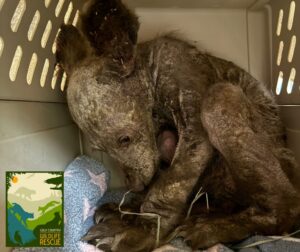Black bears are icons of strength and majesty in the wild — symbols of nature’s raw beauty. But when stripped of that strength, their vulnerability is deeply moving.
In December 2024, rescuers at Gold Country Wildlife Rescue (GCWR) in North Auburn, California, were alerted to a case that would haunt even their seasoned hearts.
A young black bear had been discovered alone in El Dorado County, clinging to life. Emaciated, dehydrated, and riddled with a painful skin infection, he was barely more than a shadow of what he should have been. Anemic and scared, the cub curled into himself inside the rescue crate, his oversized paws a heartbreaking contrast to his frail, nearly hairless body.
Black bears are awe-inspiring creatures — a blend of raw power and quiet majesty. But when one is stripped of its health, fur, and spirit, the heartbreak is undeniable.
That was the scene in December 2024 when Gold Country Wildlife Rescue (GCWR) in North Auburn, California, received a call that would shake even their most seasoned rescuers. A severely malnourished black bear cub had been spotted alone in El Dorado County — orphaned, weak, and clinging to life.
“It was heartbreaking to see a bear cub in such terrible condition,” shared Chelsea Engberg, GCWR’s marketing and outreach manager.
The cub, barely 20 pounds, was suffering from extreme dehydration, anemia, and a painful skin infection that had left him nearly hairless. He sat hunched in his crate, too weak to move, staring down at his oversized paws — a haunting image of what he had endured.
Rescuers sprang into action with a meticulous care plan tailored to his fragile condition. Every small milestone became a reason to hope. And then, after weeks of intensive treatment, something extraordinary happened: soft fuzz began to appear on his bare face.
“While it might not seem like a big change, seeing fur fuzz grow on his face is an exciting next step in his healing journey,” GCWR shared in a hopeful update.
As the weeks passed, the cub’s wild spirit began to reemerge. He started to play, splash in a kiddie pool, and lounge in a hammock made from firehose material. Caregivers kept their distance, determined to help him stay wild — and give him a real shot at freedom.
By February 2025, the transformation was breathtaking. The once-frail, unrecognizable cub now looked every bit the black bear he was born to be.
“We are always amazed by the wild animals in our care, and this bear cub is one of the most incredible recoveries we have ever seen,” said Engberg.
The question remained: Could he return to the wild? In consultation with the California Department of Fish and Wildlife (CDFW), a decision was made. On May 13, 2025, GCWR announced that while the cub wouldn’t be released into the wild, he would soon move to a permanent sanctuary — a safe haven where he could continue to grow and thrive.
“If you’ve not seen this cub before, he came to us late last year sick and almost completely without fur,” GCWR wrote on Facebook. “Now, he’s nearly ready for his forever sanctuary home.”
It’s a bittersweet resolution — not a return to the wild, but a life filled with care, comfort, and dignity. And above all, it’s a testament to the power of compassion, resilience, and expert wildlife care.
“He was in such poor condition when he arrived that, in many ways, he didn’t even resemble a bear,” Engberg reflected. “The fact that he’s regrown so much of his fur and remains wild at heart is something that fills our team with pride every single day.”
Dana Fasolette, GCWR’s Director of Animal Care, put it best:
“His journey highlights the true power of collaborative care in wildlife rehabilitation.”
From desperate beginnings to a future filled with hope — this little bear’s transformation is nothing short of extraordinary.

